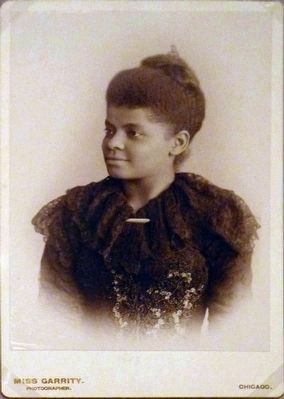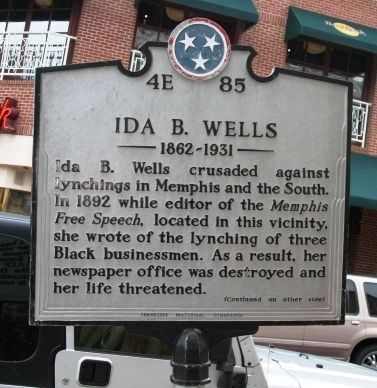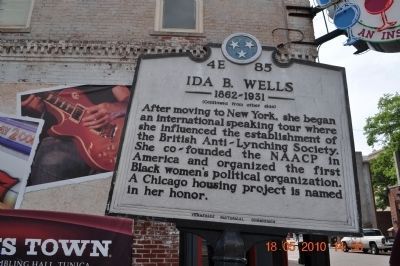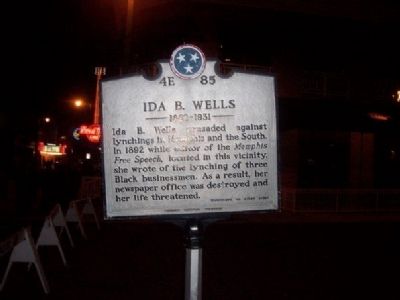Downtown Memphis in Shelby County, Tennessee — The American South (East South Central)
Ida B. Wells
1862–1931
After moving to New York, she began an international speaking tour where she influenced the establishment of the British Anti-Lynching Society. She cofounded the NAACP in America and organized the first Black women’s political organization. A Chicago housing project is named in her honor.
Erected by Tennessee Historical Commission. (Marker Number 4E 85.)
Topics and series. This historical marker is listed in these topic lists: African Americans • Civil Rights • Communications • Women. In addition, it is included in the Tennessee Historical Commission series list. A significant historical year for this entry is 1892.
Location. 35° 8.363′ N, 90° 3.067′ W. Marker is in Memphis, Tennessee, in Shelby County. It is in Downtown Memphis. Marker is on Beale Street, on the right when traveling south. Cannot be seen by car as Beale St. is limited to pedestrian traffic. Touch for map. Marker is in this post office area: Memphis TN 38103, United States of America. Touch for directions.
Other nearby markers. At least 8 other markers are within walking distance of this marker. Pee Wee Saloon (a few steps from this marker); Beale Street Historic District (within shouting distance of this marker); Rufus Thomas, Jr. (within shouting distance of this marker); George Jackson (within shouting distance of this marker); Nat D. Williams (within shouting distance of this marker); The Gillis Brothers (about 300 feet away, measured in a direct line); Chop Suey Café / Chinese Merchants on Beale Street (about 400 feet away); Hooks Brothers Photography (about 400 feet away). Touch for a list and map of all markers in Memphis.
Also see . . . Southern Horrors: Lynch Law in All Its Phases. By Ida B. Wells-Barnett. 1892. Project Gutenberg. (Submitted on October 28, 2015, by Allen C. Browne of Silver Spring, Maryland.)
Additional keywords. humanitarian, NAACP - National Association for the Advancement of Colored People

1893
4. Ida B. Wells-Barnett
This c.1893 photo of Ida B. Wells-Barnett by Mary Garrity hangs in the National Portrait Gallery in Washington, DC.
“The daughter of former slaves, Ida B. Wells sued the Chesapeake, Ohio, and Southwestern Railway in 1883 after being dragged from her seat for refusing to move to a segregated railcar. Her anger over this incident spurred her to begin contributing articles to black-owned newspapers; she became part owner and editor of the Memphis Free Speech and Headlight in 1889. After three black businessmen were lynched in Memphis in 1892, Wells launched what became a four-decade-long anti-lynching crusade. She vigorously investigated other lynchings and published her groundbreaking treatise on the topic, Southern Horrors: Lynch Law in All Its Phases.” — National Portrait Gallery
“The daughter of former slaves, Ida B. Wells sued the Chesapeake, Ohio, and Southwestern Railway in 1883 after being dragged from her seat for refusing to move to a segregated railcar. Her anger over this incident spurred her to begin contributing articles to black-owned newspapers; she became part owner and editor of the Memphis Free Speech and Headlight in 1889. After three black businessmen were lynched in Memphis in 1892, Wells launched what became a four-decade-long anti-lynching crusade. She vigorously investigated other lynchings and published her groundbreaking treatise on the topic, Southern Horrors: Lynch Law in All Its Phases.” — National Portrait Gallery
Credits. This page was last revised on February 7, 2023. It was originally submitted on March 6, 2006, by Amber of Granville, Ohio. This page has been viewed 5,349 times since then and 138 times this year. Last updated on July 19, 2008, by R. E. Smith of Nashville, Tennessee. Photos: 1. submitted on March 20, 2008, by R. E. Smith of Nashville, Tennessee. 2. submitted on September 21, 2010, by Sandra Hughes Tidwell of Killen, Alabama, USA. 3. submitted on March 6, 2006, by Amber of Granville, Ohio. 4. submitted on October 28, 2015, by Allen C. Browne of Silver Spring, Maryland. • J. J. Prats was the editor who published this page.


